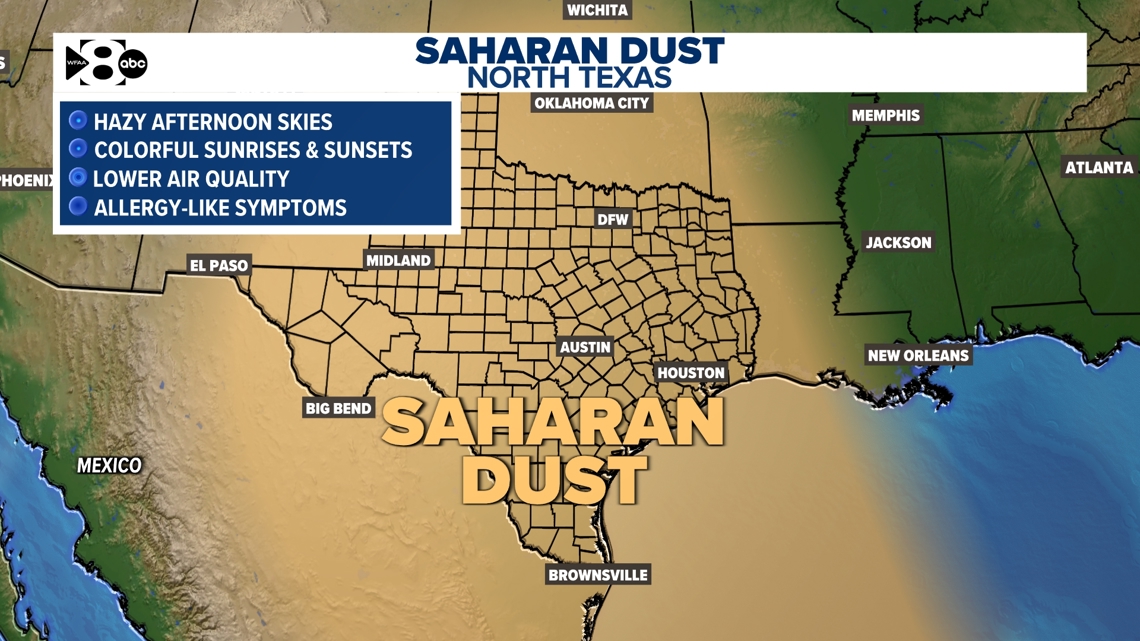North Texas Sky Turns Orange: Saharan Dust Explained

Welcome to your ultimate source for breaking news, trending updates, and in-depth stories from around the world. Whether it's politics, technology, entertainment, sports, or lifestyle, we bring you real-time updates that keep you informed and ahead of the curve.
Our team works tirelessly to ensure you never miss a moment. From the latest developments in global events to the most talked-about topics on social media, our news platform is designed to deliver accurate and timely information, all in one place.
Stay in the know and join thousands of readers who trust us for reliable, up-to-date content. Explore our expertly curated articles and dive deeper into the stories that matter to you. Visit Best Website now and be part of the conversation. Don't miss out on the headlines that shape our world!
Table of Contents
North Texas Sky Turns Orange: Saharan Dust Explained
North Texas residents were greeted with a spectacular, yet slightly unsettling, sight this week: an orange-tinged sky. The culprit? A massive plume of Saharan dust, traveling thousands of miles across the Atlantic Ocean. This natural phenomenon, while visually striking, raises questions about its impact on air quality and overall health. Let's delve into the science behind this dusty spectacle and explore its effects.
What is Saharan Dust?
Saharan dust, also known as the Saharan Air Layer (SAL), originates from the vast Sahara Desert in Africa. Strong winds lift fine sand and dust particles high into the atmosphere, creating massive plumes that can be carried across the Atlantic by prevailing winds. These dust particles, composed primarily of mineral particles like clay and silt, can travel thousands of miles, reaching the Caribbean, the Gulf Coast, and even as far as North Texas.
Why the Orange Sky?
The orange hue is a direct result of the dust particles scattering sunlight. Sunlight is composed of different wavelengths of light, and the dust particles preferentially scatter the shorter wavelengths (blue and green), allowing the longer wavelengths (reds and oranges) to dominate what we see. This effect is similar to what causes sunsets and sunrises to appear reddish or orange. The higher the concentration of dust particles in the atmosphere, the more intense the orange coloration becomes.
Impact on Air Quality and Health:
While visually stunning, Saharan dust can impact air quality. The fine dust particles can irritate the respiratory system, causing coughing, sneezing, and shortness of breath, particularly in individuals with pre-existing respiratory conditions like asthma or allergies. [Link to CDC website on air quality and health]. It’s crucial for those with respiratory sensitivities to monitor air quality reports during periods of high dust concentration and take necessary precautions, such as limiting outdoor activities.
Environmental Effects:
Beyond human health, Saharan dust also has significant environmental consequences. While some nutrients are carried along with the dust, contributing to fertilization in certain regions, the high concentration of dust can also negatively impact visibility and contribute to air pollution. Furthermore, the dust can affect marine ecosystems [Link to relevant scientific study] by altering ocean water chemistry and light penetration.
How Long Will It Last?
The duration of the Saharan dust event varies depending on weather patterns. Typically, these events last for several days, sometimes even a week or more. Monitoring local weather forecasts and air quality reports will provide the most up-to-date information on the dust's persistence in the North Texas area. [Link to local news weather website].
Taking Precautions:
- Check air quality reports: Regularly consult your local air quality index (AQI) to assess current conditions.
- Limit outdoor activities: Reduce time spent outdoors, especially during peak dust concentration periods.
- Protect yourself: Wear a mask when outside, if necessary, particularly if you have respiratory sensitivities.
- Keep your home clean: Regularly clean your home to remove dust particles that may have settled indoors.
The orange sky over North Texas serves as a captivating reminder of the vastness of natural phenomena and their impact on our daily lives. Staying informed about air quality and taking appropriate precautions are crucial during events like these. Remember to stay updated on local news and weather reports for the latest information.

Thank you for visiting our website, your trusted source for the latest updates and in-depth coverage on North Texas Sky Turns Orange: Saharan Dust Explained. We're committed to keeping you informed with timely and accurate information to meet your curiosity and needs.
If you have any questions, suggestions, or feedback, we'd love to hear from you. Your insights are valuable to us and help us improve to serve you better. Feel free to reach out through our contact page.
Don't forget to bookmark our website and check back regularly for the latest headlines and trending topics. See you next time, and thank you for being part of our growing community!
Featured Posts
-
 Remembering Al Roker Jr Sheinelle Jones Husband Dies At 45
May 30, 2025
Remembering Al Roker Jr Sheinelle Jones Husband Dies At 45
May 30, 2025 -
 Understanding Duke Energys Ohio Electric Rate Increase Effective June 1
May 30, 2025
Understanding Duke Energys Ohio Electric Rate Increase Effective June 1
May 30, 2025 -
 California High School Track Final Transgender Athlete Victory Prompts Rule Review
May 30, 2025
California High School Track Final Transgender Athlete Victory Prompts Rule Review
May 30, 2025 -
 No Substantiation For Racist Remarks Claims Wnba Statement On Sky Fever Game Incident
May 30, 2025
No Substantiation For Racist Remarks Claims Wnba Statement On Sky Fever Game Incident
May 30, 2025 -
 California High School Track New Rules In Spotlight After Trans Athletes Victory
May 30, 2025
California High School Track New Rules In Spotlight After Trans Athletes Victory
May 30, 2025
